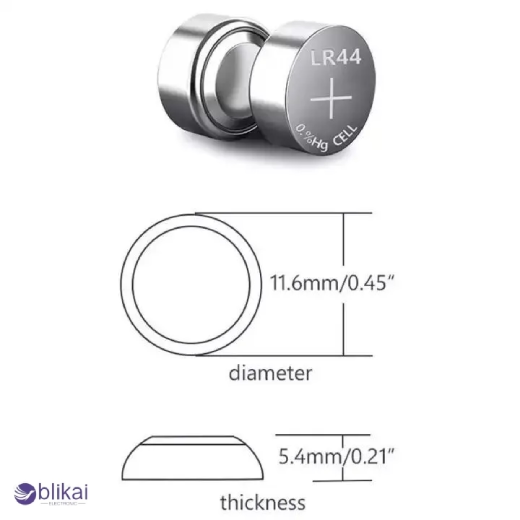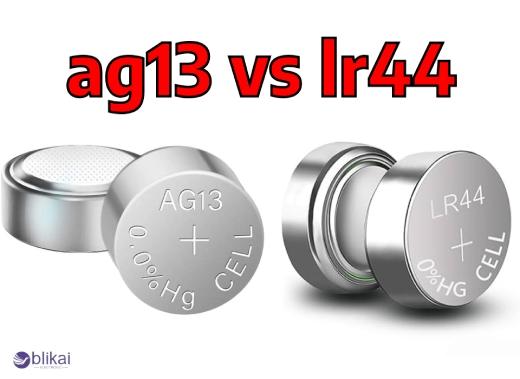AG13 vs LR44: Key Differences, Compatibility & Applications
What Are AG13 and LR44 Batteries?
Chemical Composition of AG13 and LR44
Both AG13 and LR44 batteries are alkaline button cells, but differ slightly in their chemical composition. The AG13 works with zinc anode and manganese dioxide cathode in alkaline electrolyte. The LR44 contains almost similar composition but chemical formulation shows a little difference.
Physical Dimensions of AG13 vs LR44
AG13 and LR44 batteries can be interchangeable most of the time, although there is a slight measurement difference between them. They both measure around 11.6mm, with the AG13 being thicker at 5.4mm as compared to 5.2mm of the LR44. This should not usually matter for compatibility in most devices.

Voltage Output Comparison
Both LR44 as well as AG13 batteries provide a nominal voltage of 1.5 volts, which is the main reason why they can be used interchangeably in many small electronic devices without the user having to worry about the performance of one device being different from the other.
Shelf Life of AG13 and LR44 Batteries
With regard to shelf life, the AG13 and LR44 batteries are pretty similar in their performance. They may last for 2 to 3 years and are stored properly before being used. Temperature, humidity, packaging, etc., can affect their service life. One should always check the "best used before" date at the same time storing these batteries in a cool and dry environment for better shelf life.
Key Differences Between AG13 and LR44
Performance in Various Temperatures
AG13 and LR44 batteries react differently to performance demands at different temperatures. AG13 batteries are better at low temperatures, maintaining their voltage output more consistently. This scenario makes them appropriate for outdoor equipment or operations within refrigerated environments. LR44 batteries, on the other hand, have a slight edge at high temperatures, with which they perform better in devices that generate heat upon usage.
Energy Capacity and Longevity
Although the two batteries are identical in size, LR44 batteries tend to carry a slightly higher energy capacity. This translates into a longer life in most applications. LR44 batteries can typically last up to 5-10% longer than AG13 batteries in the same application. However, actual longevity will depend on the device and usage patterns.
Cost Comparison: AG13 vs LR44
Cost-wise, AG13 batteries are generally less expensive than LR44 batteries. The cost variation is usually slight, but it would matter in case of bulk purchasing or for purposes of replacement. The increased longevity of LR44 batteries can nevertheless offset the original cost disparity in specific uses to make them cheaper in the long run for some applications.
Environmental Impact of AG13 and LR44
LR44 and AG13 batteries contain veritably little mercury and other dangerous accouterments. In fact, LR44 batteries are much more eco-friendly because they live longer, which implies that smaller batteries will be thrown down in the tip over time. Similar batteries need to be disposed of and reclaimed in the right way to minimize their impact on the environment.
Compatibility of AG13 and LR44 Batteries
Interchangeability in Devices
AG13 and LR44 batteries are commonly used interchangeably due to their identical voltage and the same size. The majority of button cell-powered devices will operate with either seamlessly. Such interchangeability is often encountered in portable electronics like calculators, keyless remote control, and watches. But let us realize that even if used interchangeably based on size, they can also differ in both performance and battery life.
Potential Risks of Substituting AG13 for LR44
Even though AG13 and LR44 batteries are similar, it is not always safe to substitute one for the other. The most crucial problem is the slight difference in capacity and chemical composition. LR44 batteries tend to have a slightly higher capacity, which can lead to longer use of devices. However, substituting an AG13 for an LR44 might make battery life decrease. In special conditions, the chemical difference can result in leakage or damage to fragile electronic parts in case the appliance is specifically designed for one type.
Adapter Options for Cross-Usage
For situations where direct substitution is not ideal, there exist adapter options that assist in encouraging cross-use of AG13 and LR44 batteries. Adapters are slender, conductive sleeves that can change the size of one battery type to fit a second type's compartment. While not ideal, adapters can be used as a practical stopgap when the exact battery type is not immediately available. But employ adapters with caution and as a last resort only to avoid damaging your device.
Common Applications of AG13 and LR44 Batteries
Consumer electronics
AG13 and LR44 batteries, being compact and dependable, find use in numerous consumer electronics. These button cells are popularly used in remote controls, crucial fobs, or small LED lights, which suit them for operations, taking a slim yet functional design.
Medical devices
AG13 and LR44 batteries are employed in small portable devices. They are used in digital thermometers, hearing aids, and glucose meters. Medical issues demand reliability and the long shelf life offered by these batteries for consistent performance.
Automotive uses
Remote keyless entry fobs are one of the many uses in which AG13 and LR44 batteries find their place in small electronics used in modern-day vehicles. These batteries are responsible for the wireless communication between the key fob and the car for keyless entry and push-button start. They are durable enough to withstand temperature fluctuations, thereby making them a good fit for automotive purposes.
Toys and games
AG13 and LR44 batteries have welcomed versatile applications within the toy industry. Battery-operated stuffed toys and small travel electronic games have never gotten any more fun because the batteries usually provide hours of fun. Battery safety and replacement convenience are prime reasons for these batteries being popular with all toy manufacturers designing toys for children.
Watches and calculators
The apparently most popular things that work with AG13 and LR44 batteries are watches and calculators. These gadgets demand tiny power sources of long-lasting effect, and button cells are the best-suited batteries. Please note that for long-term accuracy, some analog and digital watches use batteries that are to such a level. The same with pocket calculators and scientific calculators, these batteries are great for use on pocket calculators and scientific calculators due to their high performance in small sizes.

Choosing the Right Battery: AG13 or LR44?
Assessing device requirements
The first consideration when going over the inventory of AG13 and LR44 batteries is to make sure that one has had a good look at the needs of the device. Check the device manual or the battery compartment for recommended battery use. Some devices work best with a particular type of battery, while others have the choice of using either. Also, pay attention when checking for the voltage requirements since minor variations can translate into differences in actual performance.
Considering usage frequency
Another factor that needs to be considered when opting for batteries is the frequency of operation. For devices that are constantly being used, for example, a calculator or a wristwatch, it's judicious to use batteries that are known to have a long life span. They're frequently recommended for the specific use of long-continuing devices, and LR44 batteries have a lesser life than AG13 batteries. On the other hand, they might be AG13 if the device is infrequently used and is needed to be on a buttress; hence, they would frequently be cheaper.
Evaluating cost-effectiveness
Though upfront costs will vary, look at the long-term worth of both battery types. LR44 batteries are usually more expensive upfront but have longer life cycles and can pay off in the end. AG13 batteries are sometimes less costly to purchase initially but will need to be replaced more often. Factor in the cost over the term of expected use to see what will be cheapest for your purposes.
Factoring in environmental concerns
Environmental impact is a growing concern. Both LR44 and AG13 batteries contain dangerous accouterments if not disposed of correctly. Some manufacturers do give further eco-friendly options with reduced mercury content, however. Use rechargeable where possible, as they reduce waste and unborn environmental burden significantly.
Conclusion: AG13 vs LR44 Batteries
AG13 and LR44 batteries are frequently allowed to be identical, but there are slight differences that can affect their use in different devices. It's important to understand these distinctions, similar as voltage, capacity, and size, to choose the right battery for your specific requirements. While they can frequently be shifted in utmost operations, it's pivotal to consider the conditions of your device and its intended use when making your selection.
For stylish performance and safety, always relate to your device's primer or the manufacturer's guidelines before choosing a battery. Whether you go with an AG13 or an LR44, make sure to handle and dispose of them duly to maximize battery life and cover the environment. Making the correct choice ensures your devices operate efficiently and reliably for times to come.
Related Articles
The Bset Introduction to AG13 Battery Equivalent
LR41 vs LR44: Everything You Need to Know (2024 Guide)
LR44 Battery: Everything You Need to Know [2024 Updated]
LR43, LR44, and LR41: Interchangeability for LR44 Batteries?
LR43, LR44, and LR41: Interchangeability for LR44 Batteries?
What’s the Difference Between LR44 and 357 ?
LR44 Battery: Everything You Need to Know [2024 Updated]
The Bset Introduction to AG13 Battery Equivalent
Comprehensive Guide to Nickel Metal Hydride (NiMH) Batteries
How to Replace a Broken 9V Battery Connector
Car Audio Battery: All You Need to Know
Need CR2450 Battery? Here's What You Should Know
H8 Battery: Specifications, Applications & Advantages
H6 Battery: Specifications, Applications & Advantages










